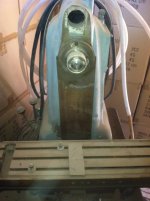RalphStirling
Aluminum
- Joined
- Apr 26, 2007
- Location
- College Place, WA
I was asked to look at some machines for a widow this afternoon,
and this Hardinge machine was not something I'm familiar with.
It was rather hemmed in by boxes, so I wasn't able to find an identifying
plate besides the "Hardinge" logo. It has a 5C collet in a spindle, and
a three-axis table. It also had a couple of extra DC motors and speed
controls bolted on for unknown purposes.
Could someone enlighten me on the model and how it was used?
Thanks!
-- Ralph
and this Hardinge machine was not something I'm familiar with.
It was rather hemmed in by boxes, so I wasn't able to find an identifying
plate besides the "Hardinge" logo. It has a 5C collet in a spindle, and
a three-axis table. It also had a couple of extra DC motors and speed
controls bolted on for unknown purposes.
Could someone enlighten me on the model and how it was used?
Thanks!
-- Ralph


